How the Highly Sensitive Person curates their home life has great impact. These tips for a peaceful home are essential to the HSP.
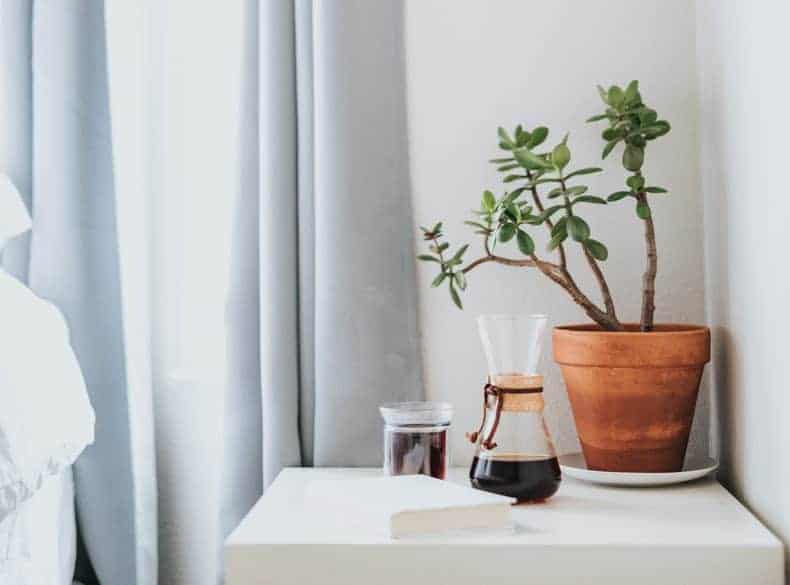
If you know me at all, you know that my mood is deeply impacted by my surroundings. Aesthetics matter to me. (Not price, but beauty and detail and vibe.) Beautiful/unique/intentional things inspire me, and my five senses deeply appreciate the small things, like the scent of lavender in the air or how the furry cushion on our bed feels to the touch.
In addition to this, I literally cover my eyes during horror movie previews at the theatre, and I tear up empathically at the drop of a hat. I’m more sensitive to the cold than most people I know, and I’m easily overwhelmed by sensory overload.
Those things, taken on their own, might just mean that I’m quirky (I am). But combined? Yup, as I discovered a few years ago, it turns out I’m an HSP all the way, baby. Maybe you are too?
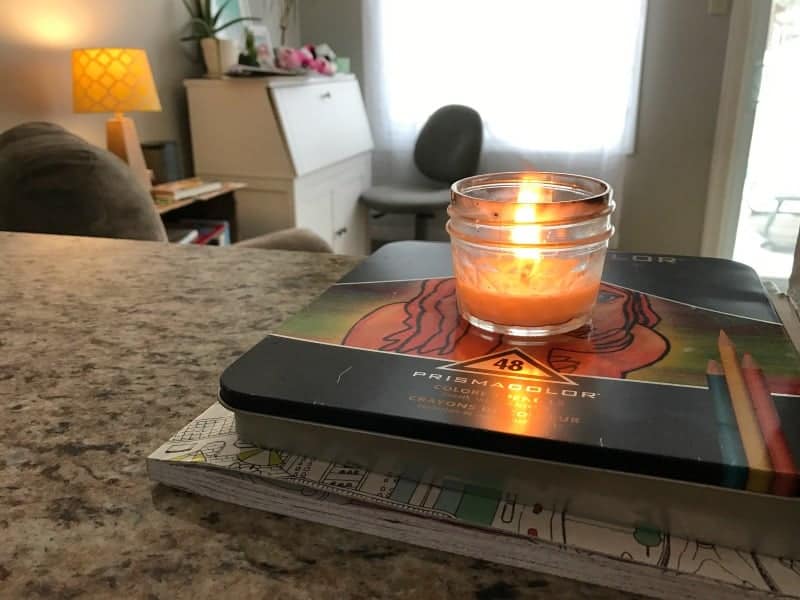
The term is Highly Sensitive Person, and Dr. Elaine Aron first began researching it in 1991. It is an innate and normal trait that occurs in approximately 15-20% of the population. It’s found in too many to be called a disorder, and yet not enough to be easily understand by the majority of society. It’s now known scientifically as Sensory-Processing Sensitivity.
You can check out the description and the self-tests on the website here. (If you are an HSP, prepare for a total lightbulb moment when you start reading on the site.)
It was one of those things that I didn’t know was missing until it was right in front my eyes. When I discovered the term “Highly Sensitive Person”, the world suddenly made more sense. And I’m pretty sure one or two of our kids are HSP as well.
Being an HSP has an impact on so many things in my life, but home is perhaps the most significant. I am an introvert, and I work from home, so I’m here a lot. And by “a lot” I mean almost all the time. (Extroverts, don’t fret: I’m an introvert and I love it.)
With moving thirteen times in our not-yet-fourteen years of marriage, I’ve had plenty of time to ponder the ways in which my home environment makes such a deep and profound impact on me. Living out of moving boxes and transitions for years lends itself well to such musings, I suppose.
Since I’ve had so many years ripe with opportunity for deconstructing this topic, I’ve got some tips pretty well nailed down by this point. And now that we’re in our long-haul home (we could conceivably be here for decades, which is JUST SO WEIRD), I have opportunity to put these thoughts together into a more cohesive plan of action.
A caveat, though: if you’re not yet settled into your “hopefully forever home,” please don’t wait to go after that homey feeling you want. All of these tips can be applied no matter what kind of home you live in, and how long you plan to live there. It’s about the vibe you get when you walk into the front door, not your decorating or housekeeping skills, or how big or fancy your home is.
The world can be so frantic – let your home be a refuge.
What do you feel when you walk into your front door? Does your home evoke a cozy feeling of peace and togetherness? Perhaps it speaks to the organized chaos of raising young children in a home that’s full of life and love. Maybe it’s decorated simply to align with your minimalist tendencies, giving you great satisfaction.
I wonder – do you love being there? If you’re an HSP, your home environment may be affecting you more than you realize. There are definitely some small things you can do that will help.
I’m sure there are tons more ideas that we could collectively come up with, but here are my personal top eleven:
11 Tips for the Highly Sensitive Person at Home
1. Include lots of plant life for its calming effect
This is a given, for me. I grew up in a house with potted plants everywhere, and it just feels natural to me. (Including the forgetting-to-water them part… until I finally remember, and revive them from the brink of death. Whatever works, right Mom?)
It’s actually scientifically proven that plant life has a calming effect on our moods, and of course, as a bonus, they also improve indoor air quality.
2. Pay attention to areas of high impact
This is one of those proactive tips that’s worth its weight in gold (that analogy doesn’t even make sense here… but just roll with it).
There are certain areas in my home that attract clutter like nobody’s business (the breakfast bar), and there are certain areas that have an instantly powerful positive impact when kept tidy (the entry way and kitchen).
When I’m mindful of those areas on a daily basis, the home feels less chaotic and more peaceful, which helps this HSP breathe a little easier.
3. Start the day with a 15-minute tidy
Speaking of being mindful of the state of tidiness in your home, I’ve recently implemented a new strategy that has made a big difference to my mental state for the day.
I was feeling constantly overwhelmed by trying to balance my work-at-home job with my homemaking job, and going a million different directions but nowhere fast.
A wise TJ-type friend advised me to set an alarm on my phone for 8:45am (about half an hour after I get back from taking the kids to the bus stop) every weekday morning. Until that alarm goes off, I go full speed with the breakfast dishes, start a load of laundry, and do a quick pick-up of the main floor. I can do it without feeling tugged in a bunch of directions because I know there’s a timer on. I don’t feel the pressure to keep going until the whole house is spotless.
(I used to feel that pressure, and would often simply avoid it altogether if I didn’t have time for perfection.)
It’s shocking (to me, anyway) just how impactful those 30 daily minutes can be. Then when the alarm goes off, I boil the kettle for tea, turn on my EO diffuser, and fire up the laptop feeling much more in control and focused.
4. Choose art that is meaningful
I’ve long identified as an artist, and find art of all kinds to be incredibly moving and inspiring. The creativity of the human spirit impresses me constantly, and I absolutely love choosing art for my home.
Recently, I was approached by the folks over at Minted to see if I wanted to pick out some complimentary art pieces for my home in exchange for sharing it with you all. Saying yes was ridiculously easy and I pored over their vast collection with careful scrutiny. There were so many pieces that I fell in love with, resulting in taking months to actually decide.
I was immediately drawn to the bright and playful colours of this piece, which arrived professionally framed, and ready to hang. The lighting in this photo is a little more warm than it looks in reality, but the picture is gorgeous either way.
It’s one of my favourite pieces, along with the blue-toned piece in the next photo. I’d like to eventually find it a perfect place on the wall, but for now it’s adorning the top of our china cabinet beautifully (along with one of the salt rocks we got from the salt mine in Utah.)
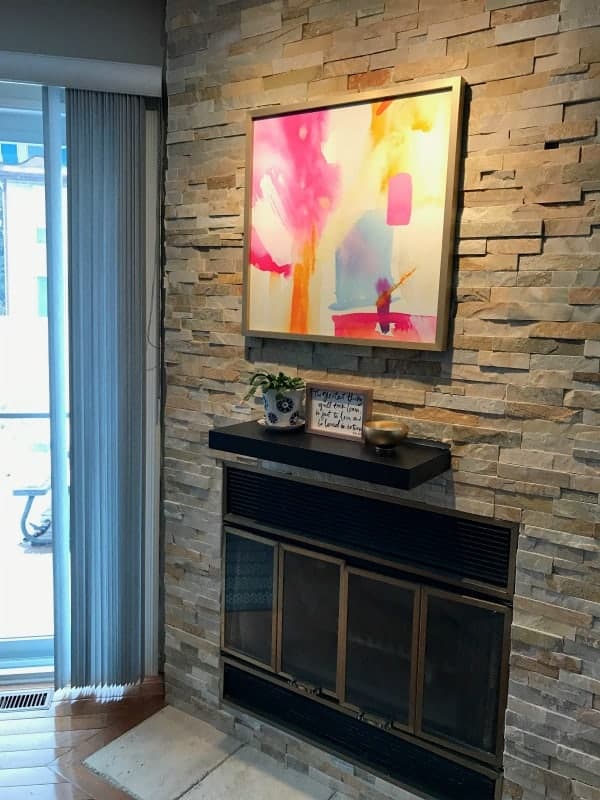

When I finally made my selections, and the art arrived on my doorstep a few weeks ago, we hung it on our bare walls.
And that’s when the lightbulb finally went on (the lightbulb that eventually inspired this post). I realized that our home is a sacred place. And that I’ve been putting most of the things on this list into practice for years, but without a cohesive understanding of the deeper purpose. It finally clicked, and I have some absolutely stunning pieces of art on my walls to thank.
It can be tough to pick out the “right” pieces of art for your walls, can’t it? If you’re anything like me, you want to pick the “perfect thing”. My criteria above all was to choose pieces that had meaning – whether literal or abstract. And, you don’t have to self-identify as an artist to enjoy the impact of art in your home.
I gravitate to abstract pieces that evoke happiness or love or tenderness or beauty. A quote with words to live by. Colours that make me happy every time I look at them.
Whether your personal vibe is complex and wild, or totally minimalist and simple, choose what you love. Choose what makes you happy to see every day. Put thought into it. You’ll be so glad that you did.
This black and white watercolour painting of a mother and baby hangs proudly in my dining room and speaks to the tender love that I have for my children, and the family we are together.
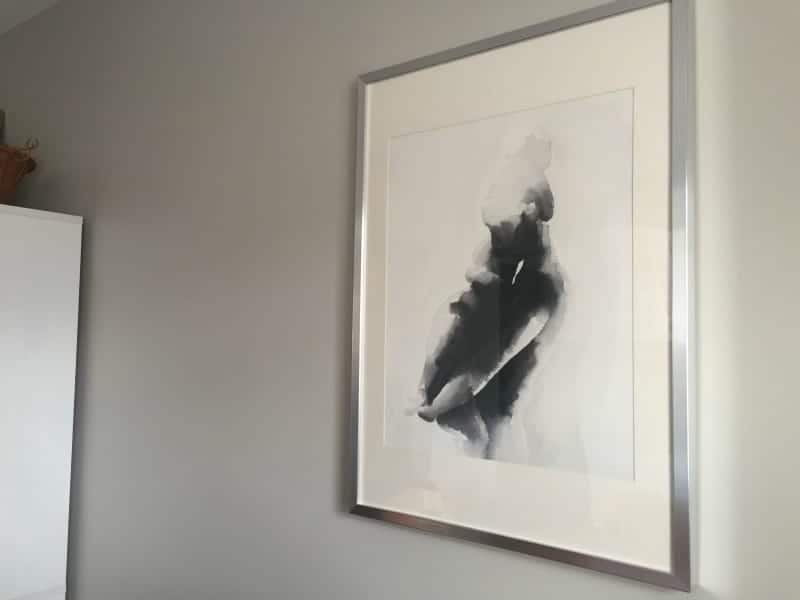
And I chose this framed quote as words to live by, and to see each and every day as a reminder about the most important thing in life. It’s one of my all-time favourite quotes.
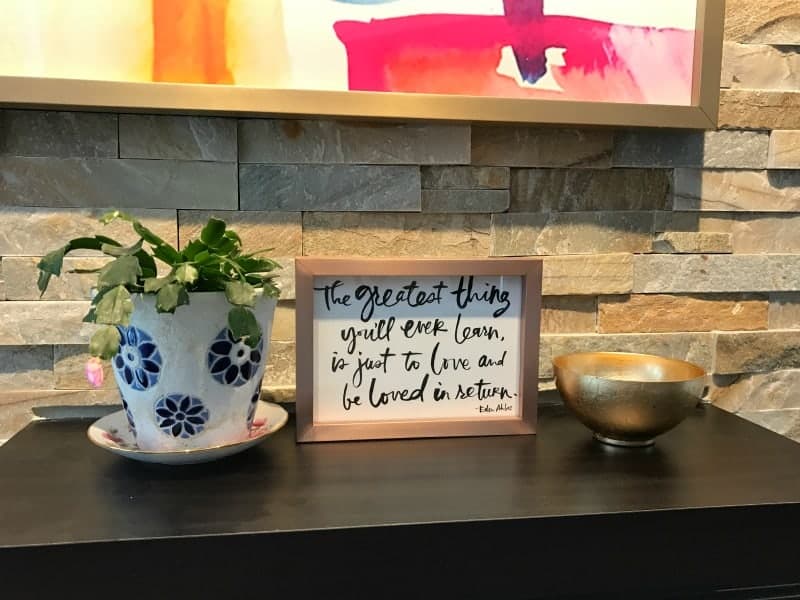
5. Plan meals to maintain good, homemade food on the table
Here’s one that I never expected would make it on a list like this: meal planning. As you may know, I’m in the midst of my 8-week meal planning challenge. The challenge was as much for myself as for my readers, and I’m totally reaping the rewards.
One of the best parts is eliminating the daily frantic panic of not knowing what to cook for dinner, and feeling perpetually unprepared. Nothing wrecks the mood quite like a hangry family and the stress of feeling like a dinnertime fail. Again.
HSP’s need to carefully guard the peacefulness of their homes, and meal planning is a surprisingly powerful way to do just that.
6. Curate playlists for specific moods
I’m a baby in the world of playlists and music. I’ve never been “in the know” about what the cool kids are listening to, but I adore a good song that connects with my mood.
So, I rely on my music-loving friends. Megan and Tsh in particular are blogging friends who both talk about playlists a fair bit on their blogs and/or podcasts. Here are a few of Tsh’s. And here are some of Megan’s. They are both music-curating geniuses, in my non-expert opinion.
I’m slowly building my own playlists of faves, and when I need to set the atmosphere at home (or get us out of a funk), good music is an obvious choice in my HSP bag of tricks.
7. Light candles
There’s just something about the flickering flame of a candle that changes the entire atmosphere of a room.
When my kids were all babies at the same time (three kids under four) and the kitchen became a disaster zone at the drop of a hat, I used to light a candle and put it amongst the dirty dishes piled high, and pretend that I was holding a candlelit vigil for my lost countertops. It was silly, but it actually changed my mood, and still has that impact on me now.
Candles are an easy way to add warmth and coziness to your home. I highly recommend beeswax candles for their lack of toxic ingredients, as well as their pleasantly natural scent. They’re wonderfully visually soothing.
8. Have a “stuff” mantra
HSPs will definitely benefit from a more intentional approach to possessions. I’ve long admired the quote by William Morris: “Have nothing in your houses that you do not know to be useful or believe to be beautiful.”
This is my mantra whenever I consider bringing a new object into our home, and when I declutter, these are the words I turn to. (Along with “Does this spark joy?” thanks to a certain book.)
Being mindful of your possessions in this way will contribute directly to your enjoyment and mood at home.
9. Use an essential oil diffuser
The five senses have great impact on an HSP, and smell is said to be one of the most powerful. I use a variety of quality essential oils in my diffuser for both medicinal and aromatherapy purposes. The right oil can help set a positive mood, or help soothe a negative one. (This is very similar to the one I have, but this one’s on my wish list)
It’s a routine that I’ve come to cherish in my morning ritual described above. Some of my favourites include lavender, sandalwood, frankincense, and a good citrus blend.
10. Adopt connection rituals with family members to keep you rooted together
As we’ve made clear, the vibe of our home is of utmost importance to me. But a good vibe doesn’t just come from beautiful art or a relatively tidy living area. It also comes from the depth of connectedness among family members.
In our family we have a nightly ritual called “Two Roses and a Thorn”. It’s our way of connecting on a deeper level after we’ve gone about our busy days apart from one another.
When we’re tucking the kids into bed, we each share “two roses” (two good things from our day) and “a thorn” (one bad thing) with each other. I’ve heard some seriously deep (and some super hilarious) answers through this routine, and it’s one of my favourite parts of the day.
An emotionally open and grounded home is a godsend to an HSP.
11. Choose materials that are pleasing to the touch
I’m big on texture and form and fabric. I love the soft crocheted afghan that hangs out in the living room, and the velvety texture of our new hand-me-down couch. I love the feeling of wood floors mixed with cozy rugs, and I love the feel of my favourite ceramic mug in my hands.
I recently bought a soft plaid flannel shirt without even trying it on simply because it felt utterly divine to my fingertips, as I ran them up and down the fabric. (Plus: it was on sale.)
I savour the way a fuzzy scarf feels against my neck on a chilly day (I’m sure if you peeked in, you’d see me absent-mindedly nuzzling it!), and I absolutely adore running my hands over our freshly-made bed with crisp white duvet and mishmash of cushions. I adore the feel of natural materials like glass, metal, and wood, and I always find myself drawn to them.
Touch has a great impact on my mood, and I’m always on the lookout for more ways to incorporate this into our home.
Navigating the world as an HSP can be tough. Big feelings and high sensitivities can honestly make you feel like the oddball sometimes. But at home? You can create the environment you crave, with the vibe you need to feel refreshed, connected, and nourished.
By tuning in to your home and curating the things and moods in it, you will cultivate a home life that fills your tank. As an HSP, this will be deeply rewarding and inevitably gratifying.
Are you an HSP? How do you curate your home environment?
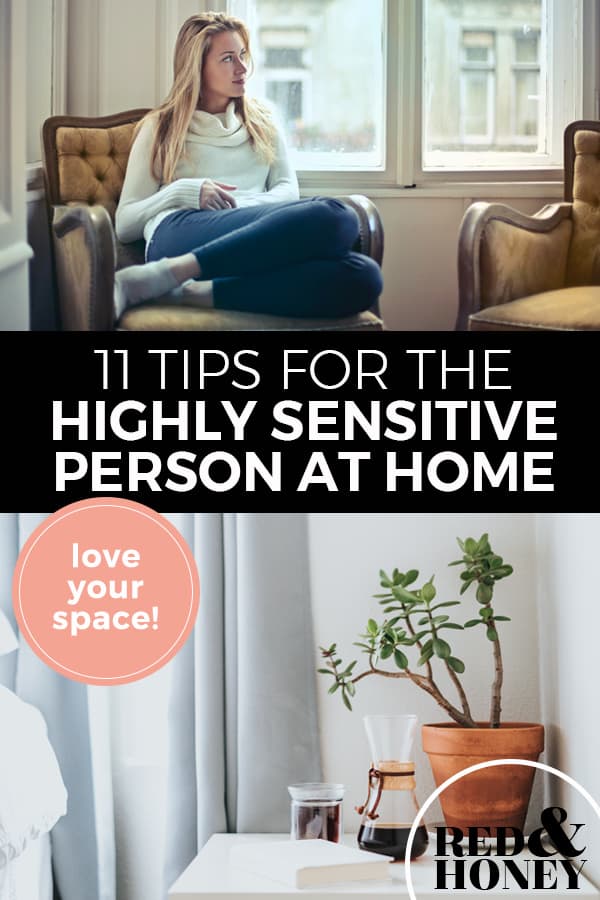






Portia
I would love to read this but hsp can’t look at all the moving pop up ads !!!
Ginger
Hello, Beth.
I’m a 66 year old wife, mother, and grandmother, living with the 3 generations of alpha males, from 70 to 9 years of age. I never knew there was a term for how I felt all these years. But finding this out at this late stage has caused me even more anxiety. I am HSP, they are not. They get their way, I do not. But I do have a private retreat, where I can lock them all out for as long as I need. Thank you for sharing your thoughts and experiences with us.
Kimberly
I’m not trying to be rude, honestly, but as a HSP, the amount of ads – pop-up and otherwise – give me anxiety. I can’t read from blogs like this, constantly having to scroll past or click out of ads, finding the content lost between them.
Beth
Hi Kimberly, sorry you had an unpleasant experience reading my post. I totally get how distracting ads and popups can be. Unfortunately, ads are my primary source of income currently, and with my hubby having lost his job due to covid, I cannot afford to reduce them right now. I hope to be able to do that in the future. Thanks for the feedback – I’ll keep it in mind.
Katie Underwood
I have never connected with anything more than this post! I’m sitting here in awe because I honestly could have written this word for word about myself!! I have to share a little story with you because I know you’ll appreciate it. When my daughter was in preschool, her teacher told me that she was special. She swore that my daughter was “Highly sensitive” and suggested that I spend time researching this topic. I did- but not extensively. Everything I read made perfect sense- but I didn’t take the time to truly understand her (or myself) anymore than I wanted to at the moment, because I was so stressed. Until today. When I read this post you wrote (thank you) I see everything a lot more clearly. My daughter is basically a mirror image of me in regards to being highly sensitive- which is a blessing- because I understand her very easily and can take the smallest cue from her and know the next direction I need to take in parenting her in that moment. (Not saying it’s ever easy, but I get the vibe and energy she’s displaying).
I just want to thank you for really bringing light to this and sharing your tips. You make perfect sense and I appreciate you.
With love,
Katie
Beth
Katie, this reply is coming way late, but better late than never? 🙂 I am so glad you found my post and that it was helpful. I absolutely love that lightning bulb moment of figuring something out about yourself and being able to better understand yourself in relation to the world. Nothing quite like it. 🙂 It makes us better parents, too, with knowing our kids better. I have a couple of HSP kids myself.
Hope you are having an awesome week,
Beth
Lou
I have the same issue. Read Elaine Aron’s Highly Sensitive Person in Love which can be found on Amazon. It’s an eye-opener for sure.
Beth
I didn’t know she had a book related to HSPs and love. I’ll look that up!
Lou
Read Elaine Aron’s Highly Sensitive People in Love which can be found on Amazon. It’s an eye opener for sure!!
JC
I too have learned that “what is wrong with me” is I’m an HSP. In my Family of Origin that was a very difficult thing to be. I’m only now coming to understand why I need my environment to be a certain way to feel relaxed and content and why I cannot deal with certain kinds of people without feeling overwhelmed. I’ve learned to walk away from Narcissistic people and I enjoy having a more peaceful life. I like my home neat and organized as a whole but don’t mind a little mess on the surface. I like my days somewhat routine with weekly meal plans and weekly scheduled activities. As long as my days are mostly peaceful I can deal with the odd last minute obligation or surprise. I just can’t live like that all the time. Thank you for the tips. It may be time for a few house plants…that sounds peaceful….and more music!!
Beth
Small steps to intentionally steer the home environment toward peace can have a HUGE impact on my days. I hope this was helpful for you too!
Megyn
I am SO GLAD I read this post. I am a highly sensitive person to the max, I just never knew it was something with a name. I’ve slowly been more aware of it, and I’ve been trying to better communicate with my husband why I react the way I do to certain situations/stimuli, and why I am so easily overwhelmed. It has definitely been a point of contention between us – he is as far from an HSP as you can get, so naturally doesn’t understand it at all. When I tell him I feel overwhelmed, he responds that I’m “choosing” to feel that way, and I just need to stop. I’m sure you can imagine how frustrating (and even hurtful) that is to me. So, I’m curious….do you know of any resources for spouses of highly sensitive people that can help them gain better understanding? It would make a world of difference for us, I think.
Jenn
I recommend asking him to read (or even reading passages to him) from the book “The Highly Sensitive Person by Elise Aron. It is very eye-opening on a personal level but also validating and puts words to what we are experiencing as HSPs; sort of translates HSP to NON-HSP. It gives Non-HSPs a framework to understand this thing they have no experience with. It’s also a wonderful, “It’s not just me!” time.
Jennifer Latham
I too am an INFP. That in itself is hard. I am the person that sobs at the movie “Up”! It is funny how almost out of a natural neccessaty the candles, succulents, (easy to keep alive), essential oils, meditation music, blankets that feel a certain way, and of course the flannel over shirt all came about for me also. I had never heard of HSP but absolutely believe it!
Thank you for sharing, it’s good to know there are others out there!